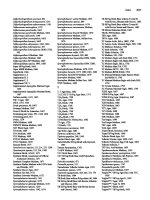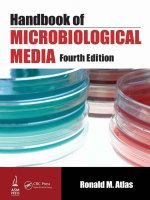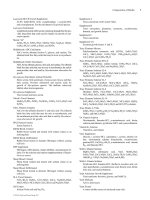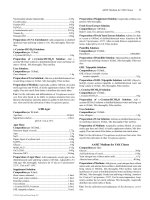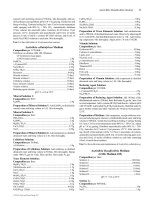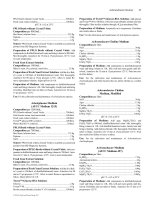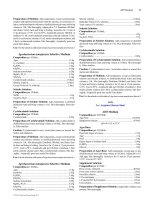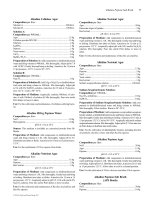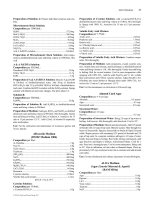Handbook of Microbiological Media, Fourth Edition part 134 pptx
Bạn đang xem bản rút gọn của tài liệu. Xem và tải ngay bản đầy đủ của tài liệu tại đây (223.37 KB, 10 trang )
OF Basal HiVeg Medium with Carbohydrate 1325
Ochromonas Medium
Composition per liter:
Glucose 20.0g
Vitamin-free casamino acids 10.0g
Diammonium hydrogen citrate 1.6g
KH
2
PO
4
0.6g
DL-Methionine 0.4g
MgSO
4
·7H
2
O 0.4g
CaCO
3
0.3g
ZnSO
4
·7H
2
O 0.22g
L-Cystine 0.2g
DL-Tryptophan 0.2g
MnSO
4
·H
2
O 0.123g
EDTA 0.1g
Na
2
MoO
4
·2H
2
O 0.1g
FeSO
4
·7H
2
O 20.0mg
Inositol 20.0mg
CoSO
4
·7H
2
O 6.0mg
Choline chloride 4.0mg
Thiamine 4.0mg
PAB 2.0mg
H
3
BO
3
1.2mg
CuSO
4
·5H
2
O 800.0μg
Biotin 20.0μg
KI 20.0μg
Tween™ 80 2.0mL
pH 5.8 ± 0.2 at 25°C
Preparation of Medium: Add components to distilled/deionized
water and bring volume to 1.0L. Mix thoroughly. Adjust pH to 5.8.
Gently heat and bring to boiling. Continue boiling for 2–3 min. Distrib-
ute 5.0mL volumes into 6 × 125mm screw-capped test tubes. Swirl the
medium while dispensing to evenly distribute the fine precipitate
which forms. Autoclave for 10 min at 15 psi pressure–121°C. Do not
overheat.
Use: For the cultivation of Ochromonas malhamensis.
Ochromonas Medium
Composition per liter:
Glucose 20.0g
Vitamin-free casamino acids 10.0g
Diammonium hydrogen citrate 1.6g
KH
2
PO
4
0.6g
MgSO
4
·7H
2
O 0.4g
CaCO
3
0.3g
ZnSO
4
·7H
2
O 0.22g
L-Cystine 0.2g
DL-Tryptophan 0.2g
MnSO
4
·H
2
O 0.123g
EDTA 0.1g
Na
2
MoO
4
·2H
2
O 0.1g
DL-Methionine 0.4g
FeSO
4
·7H
2
O 20.0mg
Inositol 20.0mg
CoSO
4
·7H
2
O 6.0mg
Choline chloride 4.0mg
Thiamine 4.0mg
PAB 2.0mg
H
3
BO
3
1.2mg
Vitamin B
12
0.4ng
CuSO
4
·5H
2
O 800.0μg
Biotin 20.0μg
KI 20.0μg
Tween™ 80 2.0mL
pH 5.8 ± 0.2 at 25°C
Preparation of Medium: Add components to distilled/deionized
water and bring volume to 1.0L. Mix thoroughly. Adjust pH to 5.8.
Gently heat and bring to boiling. Continue boiling for 2–3 min. Distrib-
ute 5.0mL volumes into 6 × 125mm screw-capped test tubes. Swirl the
medium while dispensing to evenly distribute the fine precipitate
which forms. Autoclave for 10 min at 15 psi pressure–121°C. Do not
overheat.
Use: For the maintenance of Ochromonas malhamensis.
Oddoux Medium
Composition per liter:
Agar 13.0g
Malt extract 8.0g
Glucose 7.0g
Casein hydrolysate 1.0g
Asparagine 0.5g
KH
2
PO
4
0.5g
MgSO
4
·7H
2
O 0.5g
Vitamin solution 10.0mL
Vitamin Solution:
Composition
per 10.0mL:
Calcium pantothenate 0.5mg
Nicotinamide 0.5mg
Pyridoxine HCl 0.5mg
Riboflavin 0.5mg
Thiamine 0.5mg
Preparation of Vitamin Solution: Add components to distilled/
deionized water and bring volume to 10.0mL. Mix thoroughly. Filter
sterilize.
Preparation of Medium: Add components, except vitamin solu-
tion, to distilled/deionized water and bring volume to 990.0mL. Mix
thoroughly. Gently heat and bring to boiling. Autoclave for 15 min at
15 psi pressure–121°C. Aseptically add 10.0mL of sterile vitamin so-
lution. Mix thoroughly. Pour into sterile Petri dishes or distribute into
sterile tubes.
Use: For the cultivation and maintenance of Boletus granulatus, Bol-
etus luteus, Lactarius deliciosus, and Tricholoma equestre.
OF Basal HiVeg Medium with Carbohydrate
Composition per liter:
NaCl 5.0g
Agar 2.0g
Plant hydrolysate 2.0g
K
2
HPO
4
0.3g
Bromthymol Blue 0.08g
Carbohydrate solution 100.0mL
pH 6.8 ± 0.2 at 25°C
Source: This medium, without carbohydrate solution, is available as
a premixed powder from HiMedia.
Carbohydrate Solution:
Composition
per 100.0mL:
Carbohydrate 10.0g
Preparation of Carbohydrate Solution: Add carbohydrate to
distilled/deionized water and bring volume to 100.0mL. Mix thorough-
ly. Filter sterilize.
© 2010 by Taylor and Francis Group, LLC
1326 Ogawa Egg Medium
Preparation of Medium: Add components, except carbohydrate
solution, to distilled/deionized water and bring volume to 1.0L. Mix
thoroughly. Gently heat and bring to boiling. Distribute into tubes in
3.0mL volumes. Autoclave for 15 min at 15 psi pressure–121°C. Cool
to 45°–50°C. Aseptically add 0.3mL of sterile carbohydrate solution to
each tube. Mix thoroughly.
Use: For the cultivation and differentiation of a variety of microorgan-
isms based on their ability to ferment a specific carbohydrate. Bacteria
that ferment the specific carbohydrate turn the medium yellow.
OF Glucose Medium, Semisolid
See: Oxidative Fermentative Glucose Medium, Semisolid
OF Glucose Medium, Semisolid with Sodium Chloride
See: Oxidative Fermentative
Glucose Medium, Semisolid, with Sodium Chloride
OF Test Medium
See: Oxidative Fermentative Test Medium
Ogawa Egg Medium
Composition per liter:
Chicken eggs, whole 200.0mL
Sodium glutamate-KH
2
PO
4
solution 100.0mL
Glycerol 6.0mL
Malachite Green (2.0% solution) 6.0mL
pH 6.8 ± 0.2 at 25°C
Sodium Glutamate-KH
2
PO
4
Solution:
Composition
per 100.0mL:
Sodium glutamate 1.0g
KH
2
PO
4
1.0g
Preparation of Sodium Glutamate-KH
2
PO
4
Solution: Add
components to distilled/deionized water and bring volume to 100.0mL.
Mix thoroughly. Filter sterilize.
Preparation of Medium: Soak eggs with 1:100 dilution of saturat-
ed mercuric chloride solution for 1 min. Aseptically break eggs into a
sterile graduated cylinder. Homogenize eggs. Add remaining compo-
nents. Mix thoroughly. Aseptically distribute into sterile tubes in
10.0mL volumes. Inspissate at 90°C (moist heat) for 60 min.
Use: For the selective isolation and cultivation of Nocardia and Rho-
dococci species.
Ogawa TB Medium
Composition per 300.0mL:
KH
2
PO
4
1.0g
Homogenized whole egg 200.0mL
Glycerol 6.0mL
Malachite Green (2% solution) 6.0mL
pH 6.5 ± 0.2 at 25°C
Homogenized Whole Egg:
Composition
per liter:
Whole eggs 18–24
Preparation of Homogenized Whole Egg: Use fresh eggs, less
than 1 week old. Scrub the shells with soap. Let stand in a soap solution
for 30 min. Rinse in running water. Soak eggs in 70% ethanol for 15
min. Break the eggs into a sterile container. Homogenize by shaking.
Filter through four layers of sterile cheesecloth into a sterile graduated
cylinder. Measure out 1.0L.
Preparation of Medium: Add components, except homogenized
whole egg, to distilled/deionized water and bring volume to 100.0mL.
Mix thoroughly. Autoclave for 15 min at 15 psi pressure–121°C. Cool
to 45°–50°C. Aseptically add 200.0mL of sterile homogenized whole
egg. Mix thoroughly. Aseptically distribute into sterile screw-capped
tubes in 7.0mL volumes. Inspissate at 85°–90°C (moist heat) for 60
min.
Use: For the isolation and cultivation of Mycobacterium species,
except for Mycobacterium leprae.
OGYE Agar
See: Oxytetracycline Glucose Yeast Extract Agar
Oil Agar Medium
Composition per liter:
Agar, purified 20.0g
NaCl 10.0g
Oil powder 10.0g
NH
4
NO
3
1.0g
MgSO
4
0.5g
Amphotericin B solution 10.0mL
K
2
HPO
4
solution 7.0mL
KH
2
PO
4
solution 3.0mL
FeCl
3
0.1mL
Oil Powder:
Composition
per 10.0g:
Hydrocarbon 10.0g
Silica gel 10.0g
Diethyl ether 30.0mL
Preparation of Oil Powder: Add 10.0g of hydrocarbon to 30.0mL
of diethyl ether. Mix thoroughly. Add 10.0g of silica gel. Allow ether
to evaporate.
Amphotericin B Solution:
Composition
per 10.0mL:
Amphotericin B 0.01g
Preparation of Amphotericin B Solution: Add amphotericin B
to distilled/deionized water and bring volume to 10.0mL. Mix thor-
oughly. Filter sterilize.
K
2
HPO
4
Solution:
Composition
per 100.0mL:
K
2
HPO
4
10.0g
Preparation of K
2
HPO
4
Solution: Add K
2
HPO
4
to distilled/de-
ionized water and bring volume to 100.0mL. Mix thoroughly. Auto-
clave for 15 min at 15 psi pressure–121°C. Cool to 25°C.
KH
2
PO
4
Solution:
Composition
per 100.0mL:
KH
2
PO
4
10.0g
Preparation of KH
2
PO
4
Solution: Add KH
2
PO
4
to distilled/de-
ionized water and bring volume to 100.0mL. Mix thoroughly. Auto-
clave for 15 min at 15 psi pressure–121°C. Cool to 25°C.
Preparation of Medium: Add components—except amphotericin
B solution, K
2
HPO
4
solution, and KH
2
PO
4
solution—to distilled/de-
ionized water and bring volume to 980.0mL. Mix thoroughly. Gently
heat and bring to boiling. Autoclave for 15 min at 15 psi pressure–
121°C. Cool to 45°–50°C. Aseptically add 10.0mL of sterile amphot-
ericin B solution, 7.0mL of sterile K
2
HPO
4
solution, and 3.0mL of ster-
ile KH
2
PO
4
solution. Mix thoroughly. Pour into sterile Petri dishes or
distribute into sterile tubes.
© 2010 by Taylor and Francis Group, LLC
ONR7a Medium 1327
Use: For the cultivation and enumeration of hydrocarbon-utilizing
bacteria by direct plating of estuarine water and sediment samples.
Oleic Albumin Complex
Composition per liter:
Bovine albumin fraction V 50.0g
NaCl 8.5g
Oleic acid 0.6mL
Preparation of Medium: Add components to distilled/deionized
water and bring volume to 1.0L. Mix thoroughly. Filter sterilize.
Use: For use in media employed for the cultivation of mycobacteria.
OM-2 Medium
(DSMZ Medium 782)
Composition per liter:
NH
4
-oxalate 15.0g
NaHCO
3
10.0g
NaH
2
PO
4
·2H
2
O 10.0g
NaS
2
O
3
·5H
2
O 1.0g
NaCl 0.7g
KCl 0.57g
MgCl
2
·6H
2
O 0.1g
CaCl
2
·2H
2
O 0.01g
pH 6.9 ± 0.2 at 25°C
Preparation of Medium: Add NH
4
-oxalate, NaH
2
PO
4
·2H
2
O, and
NaHCO
3
to distilled/deionized water and bring volume to 1.0L. Mix
thoroughly after adding each until dissolved. Add remaining compo-
nents. Mix thoroughly. Distribute into tubes or flasks. Autoclave for 20
min at 15 psi pressure–121°C.
Use: For the cultivation of Ammoniphilus oxalivorans and Ammoniphi-
lus oxalaticus.
ONE Broth-Listeria
(Oxoid Novel Enrichment (ONE) Broth-Listeria)
Composition per 1005.0mL:
Peptone 28.0g
Salt mix 10.0g
Carbohydrate mix 6.0g
ONE Broth-Listeria selective supplement (proprietary) 5.0mL
pH 7.4 ± 0.2 at 25°C
Source: This medium is available as a premixed powder from Oxoid
Unipath.
Preparation of Medium: Add components, except ONE Broth-
Listeria selective supplement, to distilled/deionized water and bring
volume to 1.0L. Mix thoroughly. Gently heat while stirring and bring
to boiling. Autoclave for 15 min at 15 psi pressure–121°C. Cool to
50°C. Aseptically add 5.0mL ONE Broth-Listeria selective supple-
ment. Mix thoroughly. Pour into sterile Petri dishes.
Use: For the selective enrichment of Listeria spp. from food and envi-
ronmental samples. A selective enrichment broth for Listeria species
from food samples in 24 hr.
Önöz Salmonella Agar
Composition per liter:
Agar 15.0g
Sucrose 13.0g
Lactose 11.5g
Trisodium citrate–5,5–hydrate 9.3g
Meat peptone 6.8g
Beef extract 6.0g
L–Phenylalanine 5.0g
Na
2
S
2
O
3
·5H
2
O 4.25g
Bile salt mixture 3.825g
Yeast extract 3.0g
Na
2
HPO
4
·2H
2
O 1.0g
Ferric citrate 0.5g
Metachrome Yellow 0.47g
MgSO
4
·7H
2
O 0.4g
Aniline Blue 0.25g
Neutral Red 0.022g
Brilliant Green 0.00166g
pH 7.1 ± 0.2 at 25°C
Preparation of Medium: Add components to distilled/deionized
water and bring volume to 1.0L. Mix thoroughly. Gently heat and bring
to boiling. Distribute into tubes or flasks. Autoclave for 15 min at 15
psi pressure–121°C. Pour into sterile Petri dishes or leave in tubes.
Use: For the isolation and cultivation of Salmonella from feces.
ONPG Broth
Composition per liter:
Peptone water 750.0mL
ONPG solution 250.0mL
pH 7.2–7.4 at 25°C
ONPG Solution:
Composition per 250.0mL:
ONPG (o-nitrophenyl-β-
D-galactopyranoside) 1.5g
Sodium phosphate buffer (0.01M, pH 7.5) 250.0mL
Preparation of ONPG Solution: Add ONPG to 250.0mL of sodi-
um phosphate buffer. Mix thoroughly. Filter sterilize.
Peptone Water:
Composition per 750.0mL:
Peptone 7.5g
NaCl 3.75g
Preparation of Peptone Water: Add components to distilled/de-
ionized water and bring volume to 750.0mL. Mix thoroughly. Gently
heat and bring to boiling. Adjust pH to 8.0–8.4. Continue boiling for
10 min. Filter through Whatman #1 filter paper. Readjust pH of filtrate
to 7.2–7.4. Autoclave for 20 min at 10 psi pressure–115°C. Cool to
25°C.
Preparation of Medium: Aseptically combine the sterile ONPG
solution with the cooled, sterile peptone water. Mix thoroughly. Asep-
tically distribute into tubes in 2.5–3.0mL volumes. Store at 4°C for up
to 1 month.
Use: For the differentiation of a variety of Gram-negative bacteria
based on production of β-galactosidase. For the differentiation of lac-
tose-delayed bacteria from lactose-negative bacteria. For the differen-
tiation of Pseudomonas cepacia (positive) and Pseudomonas malto-
phila (positive) from other Pseudomonas species (negative). Bacteria
that produce β-galactosidase turn the medium yellow.
ONR7a Medium
(DSMZ Medium 950)
Composition per liter:
Solution 1 800.0mL
Solution 2 150.0mL
Solution 3 50.0mL
© 2010 by Taylor and Francis Group, LLC
1328 ONR7a Medium
Solution 1:
Composition
per 800.0mL:
NaCl 22.79g
Na
2
SO
4
3.98g
TAPSO 1.3g
KCl 0.72g
NH
4
Cl 0.27g
NaBr 83.0mg
NaHCO
3
31.0mg
H
3
BO
3
27.0mg
NaF 2.60mg
Na
2
HPO
4
·7H
2
O 89.0mg
pH 7.6 ± 0.2 at 25°C
Preparation of Solution 1: Add components to distilled/deionized
water and bring volume to 800.0mL. Mix thoroughly. Adjust pH to 7.6.
with NaOH. Autoclave for 15 min at 15 psi pressure–121°C. Cool to
25°C.
Solution 2:
Composition
per 150.0mL:
MgCl
2
·6H
2
O 11.18g
CaCl
2
·2H
2
O 1.46g
SrCl
2
·6H
2
O 24.0mg
Preparation of Solution 2: Add components to distilled/deionized
water and bring volume to 150.0mL. Mix thoroughly. Autoclave for 15
min at 15 psi pressure–121°C. Cool to 25°C.
Solution 3:
Composition
per 50.0mL:
FeCl
2
·4H
2
O 2.0mg
Preparation of Solution 3: Add FeCl
2
·4H
2
O to distilled/deionized
water and bring volume to 50.0mL. Mix thoroughly. Autoclave for 15
min at 15 psi pressure–121°C. Cool to 25°C.
Preparation of Medium: Aseptically combine 800.0mL sterile so-
lution 1, 150.0mL sterile solution 2, and 50.0mL sterile solution 3. Mix
thoroughly. Distribute into sterile tubes or flasks.
Use: For the cultivation of Oleiphilus messinensis.
ONR7a Medium
(DSMZ Medium 983)
Composition per liter:
NaCl 22.79g
Agar 15.0g
Na
2
SO
4
3.98g
CaCl
2
·2H
2
O 1.46g
TAPSO 1.3g
MgCl
2
·6H
2
O 1.18g
KCl 0.72g
NH
4
Cl 0.27g
Na
2
HPO
4
89.0mg
NaBr 83.0mg
NaHCO
3
31.0mg
H
3
BO
3
27.0mg
SrCl
2
·6H
2
O 24.0mg
NaF 2.6mg
FeCl
2
·4H
2
O 2.0mg
Tetradecane 10.0mL
pH 7.0 ± 0.2 at 25°C
Preparation of Medium: Add components, except tetradecane, to
distilled/deionized water and bring volume to 1.0L. Mix thoroughly.
Adjust pH to 7.0. Distribute into tubes or flasks. Gently heat while stir-
ring and bring to boiling. Mix thoroughly. Autoclave for 15 min at 15
psi pressure–121°C. Pour into Petri dishes. Invert after agar solidifies.
Add tetradecane to the lid of the Petri dish.
Use: For the cultivation of Oleispira antarctica.
OR Indicator Agar
(Oxidation-Reduction Indicator Agar)
Composition per liter:
Agar 15.0g
Sodium glycerol phosphate 10.0g
Sodium thioglycolate 1.7g
CaCl
2
·2H
2
O 0.1g
Methylene Blue 6.0mg
Preparation of Medium: Add components to distilled/deionized
water and bring volume to 1.0L. Mix thoroughly. Gently heat and bring
to boiling. Distribute into tubes or flasks. Autoclave for 15 min at 15
psi pressure–121°C. Pour into sterile Petri dishes or leave in tubes.
Use: For use as an indicator of oxygen-free conditions in anaerobic
culture chambers.
Oral Fusobacterium Medium
Composition per liter:
Agar 15.0g
Proteose peptone 10.0g
Na
2
HPO
4
5.0g
Glucose 5.0g
Beef extract 3.0g
Soluble starch 2.0g
NaNO
3
1.0g
Yeast extract 1.0g
L-Cysteine·HCl·H
2
O 0.5g
Ethyl Violet solution 10.0mL
Bacitracin solution 10.0mL
pH 7.6 ± 0.2 at 25°C
Ethyl Violet Solution:
Composition
per 10.0mL:
Ethyl Violet 0.04g
Preparation of Ethyl Violet Solution: Add Ethyl Violet to dis-
tilled/deionized water and bring volume to 10.0mL. Mix thoroughly.
Filter sterilize.
Bacitracin Solution:
Composition
per 10.0mL:
Bacitracin 1.0mg
Preparation of Bacitracin Solution: Add bacitracin to distilled/
deionized water and bring volume to 10.0mL. Mix thoroughly. Filter
sterilize.
Preparation of Medium: Add components, except Ethyl Violet so-
lution and bacitracin solution, to distilled/deionized water and bring
volume to 980.0mL. Mix thoroughly. Gently heat and bring to boiling.
Autoclave for 15 min at 15 psi pressure–121°C. Cool to 45°–50°C.
Aseptically add sterile Ethyl Violet solution and bacitracin solution.
Mix thoroughly. Pour into sterile Petri dishes or distribute into sterile
tubes.
Use: For the selective isolation and cultivation of oral Fusobacterium
species, especially Fusobacterium nucleatum.
© 2010 by Taylor and Francis Group, LLC
Orange Serum HiVeg Agar 1329
Oral Treponema Medium
Composition per 1250.0mL:
Veal heart, fresh ground 1.0Kg
Thiopeptone 20.0g
NaCl 10.0g
Ionagar No. 2 2.0g
Glutathione (1% solution) 100.0mL
Rabbit serum or ascitic fluid 100.0mL
Eggs, whole fresh 2
pH 6.8–7.0 at 25°C
Preparation of Medium: Add agar to 50.0mL of distilled/deion-
ized water. Gently heat and bring to boiling. Autoclave for 15 min at
15 psi pressure–121°C. Cool to 45°–50°C. In a separate flask, add fine-
ly ground veal heart to 1.0L of distilled/deionized water. Add remain-
ing components, except glutathione, rabbit serum, and agar. Gently
heat and bring to 70°C. Adjust pH to 7.4. Gently heat and bring to
100°C. Continue heating at 100°C for 2 hr. Skim off fat. Filter through
glass wool. Adjust pH to 7.6. Gently heat and bring to 100°C. Maintain
at 100°C for 30 min. Store at 4°C for 18 hr. Sterilize in an Arnold ster-
ilizer for 30 min at 100°C on 2 consecutive days. Cool to 45°–50°C.
Aseptically add rabbit serum, glutathione solution, and sterile cooled
agar solution. Mix thoroughly. Aseptically distribute into sterile tubes
or flasks.
Use: For the isolation and cultivation of Treponema denticola and
Treponema oralis.
Orange Serum Agar
Composition per liter:
Agar 17.0g
Pancreatic digest of casein 10.0g
Glucose 4.0g
Yeast extract 3.0g
K
2
HPO
4
2.5g
Orange serum 200.0mL
pH 5.5 ± 0.2 at 25°C
Source: This medium is available as a premixed powder from BD Di-
agnostic Systems.
Preparation of Medium: Add components to distilled/deionized
water and bring volume to 1.0L. Mix thoroughly. Gently heat and bring
to boiling. Distribute into tubes or flasks. Autoclave for 15 min at 15
psi pressure–121°C. Pour into sterile Petri dishes or leave in tubes.
Use: For the cultivation and enumeration of microorganisms associ-
ated with the spoilage of citrus products. For the cultivation of lactoba-
cilli, other aciduric microorganisms, and pathogenic fungi.
Orange Serum Agar
Composition per liter:
Agar 14.0g
Pancreatic digest of casein 10.0g
Glucose 4.0g
Orange serum, equivalent solids 3.5g
Yeast extract 3.0g
K
2
HPO
4
2.5g
pH 5.5 ± 0.2 at 25°C
Source: This medium is available as a premixed powder from Oxoid
Unipath.
Preparation of Medium: Add components to distilled/deionized
water and bring volume to 1.0L. Mix thoroughly. Gently heat and bring
to boiling. Distribute into tubes or flasks. Autoclave for 15 min at 15
psi pressure–121°C. Pour into sterile Petri dishes or leave in tubes.
Use: For the isolation and enumeration of spoilage organisms from cit-
rus products.
Orange Serum Agar
Composition per liter:
Agar 15.5g
Orange serum 10.0g
Pancreatic digest of casein 10.0g
Glucose 4.0g
Yeast extract 3.0g
K
2
HPO
4
2.5g
pH 5.5 ± 0.2 at 25°C
Source: This medium is available as a premixed powder from BD Di-
agnostic Systems.
Preparation of Medium: Add components to distilled/deionized
water and bring volume to 1.0L. Mix thoroughly. Gently heat and bring
to boiling. Distribute into tubes or flasks. Autoclave for 10 min at 15
psi pressure–121°C. Pour into sterile Petri dishes or leave in tubes.
Use: For the enumeration and cultivation of microorganisms from cit-
rus juice and other products. For the cultivation of lactobacilli, patho-
genic fungi, and other aciduric microorganisms.
Orange Serum Broth Concentrate 10X
Composition per liter:
Pancreatic digest of casein 10.0g
Glucose 4.0g
Yeast extract 3.0g
K
2
HPO
4
2.5g
Orange serum concentrate 100.0mL
pH 5.6 ± 0.2 at 25°C
Source: This medium is available as a premixed solution from BD Di-
agnostic Systems.
Preparation of Medium: Add components to distilled/deionized
water and bring volume to 1.0L. Mix thoroughly. Distribute into tubes
or flasks. Autoclave for 15 min at 15 psi pressure–121°C.
Use: For the cultivation and enumeration of microorganisms associ-
ated with the spoilage of citrus products. For the cultivation of lactoba-
cilli, other aciduric microorganisms, and pathogenic fungi.
Orange Serum HiVeg Agar
Composition per liter:
Agar 17.0g
Plant hydrolysate 10.0g
Orange serum (solids from 200mL) 9.0g
Glucose 4.0g
Yeast extract 3.0g
K
2
HPO
4
2.5g
pH 5.5 ± 0.2 at 25°C
Source: This medium is available as a premixed powder from Hi-
Media.
Preparation of Medium: Add components to distilled/deionized
water and bring volume to 1.0L. Mix thoroughly. Gently heat and bring
to boiling. Distribute into tubes or flasks. Autoclave for 15 min at 15
psi pressure–121°C. Pour into sterile Petri dishes or leave in tubes.
© 2010 by Taylor and Francis Group, LLC
1330 Orange Serum HiVeg Broth
Use: For the cultivation and enumeration of microorganisms associ-
ated with the spoilage of citrus products. For the cultivation of lactoba-
cilli, other aciduric microorganisms, and pathogenic fungi.
Orange Serum HiVeg Broth
Composition per liter:
Plant hydrolysate 10.0g
Orange serum (solids from 200mL) 9.0g
Glucose 4.0g
Yeast extract 3.0g
K
2
HPO
4
2.5g
pH 5.5 ± 0.2 at 25°C
Source: This medium is available as a premixed powder from Hi-
Media.
Preparation of Medium: Add components to distilled/deionized
water and bring volume to 1.0L. Mix thoroughly. Gently heat and bring
to boiling. Distribute into tubes or flasks. Autoclave for 15 min at 15
psi pressure–121°C.
Use:For the cultivation of lactobacilli, other aciduric microorganisms,
and pathogenic fungi.
Organic Acid Medium KP
(Organic Acid Medium, Kauffmann and Petersen)
Composition per liter:
Gelatin 10.0g
Bromthymol Blue 0.024g
Organic acid solution 100.0mL
pH 7.4 ± 0.2 at 25°C
Organic Acid Solution:
Composition
per 100.0mL:
Organic acid 10.0g
Preparation of Organic Acid Solution: Add organic acid to dis-
tilled/deionized water and bring volume to 100.0mL. Sodium potassi-
um
D-tartrate, sodium citrate, or mucic acid may be used. Mix
thoroughly.
Preparation of Medium: Add components, except organic acid so-
lution, to distilled/deionized water and bring volume to 900.0mL. Mix
thoroughly. Gently heat and bring to boiling. Autoclave for 15 min at 15
psi pressure–121°C. Cool to 45°–50°C. Aseptically add sterile organic
acid solution. Mix thoroughly. Aseptically distribute into sterile tubes or
flasks.
Use: For the cultivation and differentiation of members of the Enter-
obacteriaceae based on their ability to utilize different organic acids as
carbon source. Bacteria that utilize tartrate, citrate, or mucate turn the
medium yellow.
Organic Medium 79
Composition per liter:
Glucose 10.0g
Peptone 10.0g
NaCl 6.0g
Pancreatic digest of casein 2.0g
Yeast extract 2.0g
pH 7.8 ± 0.2 at 25°C
Preparation of Medium: Add components to tap water and bring
volume to 1.0L. Mix thoroughly. Distribute into tubes or flasks. Auto-
clave for 15 min at 15 psi pressure–121°C.
Use: For the cultivation of Acinetobacter species, Actinomadura
aurantiaca, Actinomadura madurae, Actinomadura pelletieri, Actino-
madura vinacea, Amycolatopsis mediterranei, Amycolatopsis orienta-
lis, Amycolatopsis sulphurea, Bacillus cereus, Bacillus laterosporus,
Bacillus licheniformis, Bacillus stearothermophilus, Cellulomonas
cellulans, Cellulomonas turbata, Citrobacter freundii, Citrobacter
koseri, Comamonas acidovorans, Corynebacterium pseudodiphtherit-
icum, Corynebacterium xerosis, Enterobacter aerogenes, Escherichia
coli, Gordona bronchialis, Gordona rubropertinctus, Gordona sputi,
Gordona terrae, Microbispora rosea, Microstreptospora cinerea,
Mycobacterium fortuitum, Mycobacterium kansasii, Mycobacterium
vaccae, Nocardia amarae, Nocardia asteroides, Nocardia brasiliensis,
Nocardia carnea, Nocardia farcinica, Nocardia globerula, Nocardia
otitidiscaviarum, Nocardia petroleophila, Nocardia species, Nocardia
transvalensis, Nocardia vaccinii, Nocardioides species, Oerskovia
species, Promicromonospora citrea, Promicromonospora enterophila,
Proteus mirabilis, Proteus rettgeri, Proteus vulgaris, Pseudomonas
aeruginosa, Pseudomonas boreopolis, Pseudomonas perlurida,
Pseudomonas putida, Pseudomonas stutzeri, Rhodococcus coprophi-
lus, Rhodococcus equi, Rhodococcus erythropolis, Rhodococcus
maris, Rhodococcus rhodnii, Rhodococcus rhodochrous, Rhodococcus
ruber, Saccharomonospora viridis, Saccharopolyspora hirsuta, Sac-
charopolyspora rectivirgula, Saccharothrix aerocolonigenes, Staphy-
lococcus aureus, Thermoactinomyces glaucus, and Tsukamurella pau-
rometabolum.
Ornithine Broth
(BAM M44)
Composition per liter:
L-Ornithine 5.0g
Peptone or gelysate 5.0g
Yeast extract 3.0g
Glucose 1.0g
Bromcresol Purple 0.02g
pH 6.5 ± 0.2 at 25°C
Preparation of Medium: Add components to distilled/deionized wa-
ter and bring volume to 1.0L. Mix thoroughly. Adjust pH so that it will be
6.5 ± 0.2 after sterilization. Distribute into 16 × 150mm screw-capped
tubes in 5.0mL volumes. Autoclave medium with loosely capped tubes for
10 min at 15 psi pressure–121°C. Screw the caps on tightly for storage and
after inoculation.
Use: For the cultivation and differentiation of bacteria based on their
ability to decarboxylate the amino acid ornithine. Bacteria that decar-
boxylate ornithine turn the medium turbid purple.
Ornithine Broth with Sodium Chloride
(BAM M44)
Composition per liter:
L-Ornithine 5.0g
Peptone or gelysate 5.0g
Yeast extract 3.0g
Glucose 1.0g
Bromcresol Purple 0.02g
pH 6.5 ± 0.2 at 25°C
Preparation of Medium: Add components to distilled/deionized wa-
ter and bring volume to 1.0L. Mix thoroughly. Adjust pH so that it will be
6.5 ± 0.2 after sterilization. Distribute into 16 × 150mm screw-capped
tubes in 5.0mL volumes. Autoclave medium with loosely capped tubes for
10 min at 15 psi pressure–121°C. Screw the caps on tightly for storage and
after inoculation.
© 2010 by Taylor and Francis Group, LLC
Osmophilic Agar 1331
Use: For the cultivation and differentiation of Vibrio spp. based on
their ability to decarboxylate the amino acid ornithine. Bacteria that
decarboxylate ornithine turn the medium turbid purple.
Orotic Acid Medium
Composition per liter:
K
2
HPO
4
6.95g
Tryptone 5.0g
Sodium orotate 2.5g
KH
2
PO
4
1.36g
Sodium thioglycolate 0.5g
Yeast extract 0.5g
Riboflavin 15.0mg
Resazurin 1.0mg
pH 7.5 ± 0.2 at 25°C
Preparation of Medium: Add components to distilled/deionized
water and bring volume to 1.0L. Mix thoroughly. Sparge with 100%
N
2
. Anaerobically distribute into tubes or flasks. Autoclave for 15 min
at 15 psi pressure–121°C.
Use: For the cultivation and maintenance of Clostridium oroticum.
OS Medium
(DSMZ Medium 887)
Composition per liter:
NaHCO
3
1.0g
Na
2
S
2
O
3
·5H
2
O 1.0g
NaCl 256.0mg
Na
2
SO
4
23.0mg
KCl 15.0mg
H
3
BO
3
10.3mg
KH
2
PO
4
1.7mg
CaCl
2
·2H
2
O 0.8mg
NaNO
3
0.3mg
FeCl
3
·6H
2
O 0.1mg
MnSO
4
·4H
2
O 0.06mg
Trace elements solution 10.0mL
pH 7.0 ± 0.2 at 25°C
Trace Elements Solution:
Composition
per liter:
MgSO
4
·7H
2
O 3.0g
Nitrilotriacetic acid 1.5g
NaCl 1.0g
MnSO
4
·2H
2
O 0.5g
CoSO
4
·7H
2
O 0.18g
ZnSO
4
·7H
2
O 0.18g
CaCl
2
·2H
2
O 0.1g
FeSO
4
·7H
2
O 0.1g
NiCl
2
·6H
2
O 0.025g
KAl(SO
4
)
2
·12H
2
O 0.02g
H
3
BO
3
0.01g
Na
2
MoO
4
·4H
2
O 0.01g
CuSO
4
·5H
2
O 0.01g
Na
2
SeO
3
·5H
2
O 0.3mg
Preparation of Trace Elements Solution: Add nitrilotriacetic
acid to 500.0mL of distilled/deionized water. Dissolve by adjusting pH
to 6.5 with KOH. Add remaining components. Add distilled/deionized
water to 1.0L. Mix thoroughly.
Preparation of Medium: Add components to distilled/deionized
water and bring volume to 1.0L. Mix thoroughly. Adjust pH to 7.0 with
Na
2
SO
4
. Autoclave for 15 min at 15 psi pressure–121°C. Distribute
10mL medium into 28mL serum bottles and seal with a rubber stopper.
Gas with atmosphere of 94% N
2
+ 3% H
2
+ 3% O
2
at 300kPa.
Use: For the cultivation and maintenance of Thermocrinis ruber.
OS Solid Medium
(DSMZ Medium 887)
Composition per liter:
Gelrite 15.0g
NaHCO
3
1.0g
Na
2
S
2
O
3
·5H
2
O 1.0g
NaCl 256.0mg
Na
2
SO
4
23.0mg
KCl 15.0mg
H
3
BO
3
10.3mg
KH
2
PO
4
1.7mg
CaCl
2
·2H
2
O 0.8mg
NaNO
3
0.3mg
FeCl
3
·6H
2
O 0.1mg
MnSO
4
·4H
2
O 0.06mg
Trace elements solution 10.0mL
pH 7.0 ± 0.2 at 25°C
Trace Elements Solution:
Composition
per liter:
MgSO
4
·7H
2
O 3.0g
Nitrilotriacetic acid 1.5g
NaCl 1.0g
MnSO
4
·2H
2
O 0.5g
CoSO
4
·7H
2
O 0.18g
ZnSO
4
·7H
2
O 0.18g
CaCl
2
·2H
2
O 0.1g
FeSO
4
·7H
2
O 0.1g
NiCl
2
·6H
2
O 0.025g
KAl(SO
4
)
2
·12H
2
O 0.02g
H
3
BO
3
0.01g
Na
2
MoO
4
·4H
2
O 0.01g
CuSO
4
·5H
2
O 0.01g
Na
2
SeO
3
·5H
2
O 0.3mg
Preparation of Trace Elements Solution: Add nitrilotriacetic
acid to 500.0mL of distilled/deionized water. Dissolve by adjusting pH
to 6.5 with KOH. Add remaining components. Add distilled/deionized
water to 1.0L. Mix thoroughly.
Preparation of Medium: Add components to distilled/deionized
water and bring volume to 1.0L. Mix thoroughly. Adjust pH to 7.0 with
Na
2
SO
4
. Autoclave for 15 min at 15 psi pressure–121°C. Pour into Pe-
tri dishes. Incubate under atmosphere of 94% N
2
+ 3% H
2
+ 3% O
2
.
Use: For the cultivation and maintenance of Thermocrinis ruber.
Osmophilic Agar
Composition per liter:
Glucose 50.0g
Agar 15.0g
Yeast extract 3.0g
pH 7.0 ± 0.2 at 25°C
Preparation of Medium: Add components to distilled/deionized
water and bring volume to 1.0L. Mix thoroughly. Gently heat and bring
to boiling. Distribute into tubes or flasks. Autoclave for 15 min at 15
psi pressure–121°C. Pour into sterile Petri dishes or leave in tubes.
© 2010 by Taylor and Francis Group, LLC
1332 Osmophilic Fungi Medium
Use: For the cultivation and maintenance of Zygosaccharomyces
rouxii.
Osmophilic Fungi Medium
(M 40 Y)
(DSMZ Medium 187)
Composition per liter:
Sucrose 400.0g
Malt extract 20.0g
Agar 20.0g
Yeast extract 5.0g
pH 6.6 ± 0.2 at 25°C
Preparation of Medium: Add components to distilled/deionized
water and bring volume to 1.0L. Mix thoroughly. Gently heat and bring
to boiling. Distribute into tubes or flasks. Autoclave for 15 min at 15
psi pressure–121°C. Pour into sterile Petri dishes or leave in tubes.
Use: For the cultivation and maintenance of Eremascus fertilis, Euro-
tium glabrum, Eurotium tonophilum, Zygosaccharomyces rouxii,
Eurotium intermedium, Eremascus albus, Eurotium tonophilum,
Chrysosporium xerophilum, Wallemia sebi, Eurotium chevalieri,
Eurotium rubrum, Zygosaccharomyces bisporus, Zygosaccharomyces
bailii, and Zygosaccharomyces rouxii.
OSrt Broth
(ATCC Medium 2340)
Composition per liter:
Yeast extract 2.0 g
Glycerol 10.0 mL
Preparation of Medium: Add components to distilled/deionized
water and bring volume to 1.0L. Mix thoroughly. Distribute into flasks
or tubes. Autoclave for 15 min at 15 psi pressure–121°C.
Use: For the cultivation and maintenance of Geodermatophilus obscu-
rus subspecies utahensis.
OTI Medium, Modified
Composition per 1100.0mL:
Beef heart, solids from infusion 100.0g
NaCl 6.0g
Polypeptone™ 5.0g
Yeast extract 5.0g
K
2
HPO
4
2.0g
Tryptose 2.0g
Agar 1.6g
Pectin 0.8g
Glucose 0.8g
Starch 0.8g
Sucrose 0.8g
Maltose 0.8g
Sodium pyruvate 0.8g
Ribose 0.8g
L-Cysteine·HCl·H
2
O 0.68g
MgSO
4
·7H
2
O 0.1g
Rumen fluid, clarified 500.0 mL
Rabbit serum, inactivated 50.0mL
Thiamine pyrophosphate solution 50.0mL
pH 7.0 ± 0.2 at 25°C
Thiamine Pyrophosphate Solution:
Composition
per 50.0mL:
Thiamine pyrophosphate 7.5mg
Preparation of Thiamine Pyrophosphate Solution: Add thia-
mine pyrophosphate to distilled/deionized water and bring volume to
50.0mL. Mix thoroughly. Filter sterilize.
Preparation of Medium: Prepare and dispense medium under O
2
-
free 100% N
2
. Add components, except rabbit serum and thiamine py-
rophosphate solution, to distilled/deionized water and bring volume to
1.0L. Mix thoroughly. Gently heat and bring to boiling. Adjust pH to
7.0. Anaerobically distribute into tubes in 10.0mL volumes. Autoclave
for 15 min at 15 psi pressure–121°C. Cool to 45°–50°C. Aseptically
add 0.5 mL of sterile rabbit solution and 0.5mL of sterile thiamine py-
rophosphate solution to each tube. Mix thoroughly.
Use: For the cultivation and maintenance of Treponema socranskii.
Ottow’s Agar Medium
Composition per liter:
Agar 13.0g
Peptone 7.5g
Beef extract 5.0g
NaCl 5.0g
Casamino acids 2.5g
Yeast extract 2.5g
Glucose 1.0g
Preparation of Medium: Add components to tap water and bring
volume to 1.0L. Mix thoroughly. Gently heat and bring to boiling. Dis-
tribute into tubes or flasks. Autoclave for 15 min at 15 psi pressure–
121°C. Pour into sterile Petri dishes or leave in tubes.
Use: For the cultivation and maintenance of Bacillus pallidus.
Ottow’s Medium
Composition per liter:
Peptone 7.5g
Meat extract 5.0g
NaCl 5.0g
Casamino acids 2.5g
Yeast extract 2.5g
Glucose 1.0g
pH 8.5 ± 0.2 at 25°C
Preparation of Medium: Add components to tap water and bring
volume to 1.0L. Mix thoroughly. Distribute into tubes or flasks. Auto-
clave for 15 min at 15 psi pressure–121°C.
Use: For the cultivation of Bacillus pallidus, Bacillus thermocloacae,
and Sphaerobacter thermophilus.
Oxacillin Resistance Screening Agar Base
Composition per liter:
NaCl 55.0g
Agar 12.5g
Peptic digest of animal tissue 11.8g
Mannitol 10.0g
Yeast extract 9.0g
LiCl 5.0g
Aniline Blue 0.2g
pH 7.2 ± 0.2 at 25°C
Source: This medium is available from HiMedia.
© 2010 by Taylor and Francis Group, LLC
Oxalate Utilization Medium 1333
Caution: Lithium chloride is harmful. Avoid bodily contact and inha-
lation of vapors. On contact with skin, wash with plenty of water im-
mediately.
Selective Supplement Solution:
Composition
per 10.0mL:
Oxacillin 2.0mg
Polymyxin B 50,000U
Preparation of Selective Supplement Solution: Add compo-
nents to distilled/deionized water and bring volume to 10.0mL. Mix
thoroughly. Filter sterilize.
Preparation of Medium: Add components, except selective sup-
plement solution, to distilled/deionized water and bring volume to
990.0mL. Mix thoroughly. Autoclave for 15 min at 15 psi pressure–
121°C. Cool to 50°C. Aseptically add selective supplement solution.
Mix thoroughly. Pour into Petri dishes or aseptically distribute into
sterile tubes.
Use: For the screening of oxacillin-resistant microorganisms.
Oxalate Maintenance Medium
Composition per liter:
Pancreatic digest of casein 10.0g
Sodium oxalate 5.0g
Na
2
CO
3
4.0g
Yeast extract 1.0g
Sodium acetate 0.82g
(NH
4
)
2
SO
4
0.5g
L-Cysteine·HCl·H
2
O 0.5g
K
2
HPO
4
0.25g
KH
2
PO
4
0.25g
MgSO
4
·7H
2
O 0.025g
Resazurin 0.001g
pH 6.8 ± 0.2 at 25°C
Preparation of Medium: Add components, except Na
2
CO
3
and L-
cysteine·HCl·H
2
O, to distilled/deionized water and bring volume to
1.0L. Mix thoroughly. Adjust pH to 6.8. Gently heat and bring to boil-
ing. Cool under O
2
-free 100% CO
2
. Add Na
2
CO
3
and L-cyste-
ine·HCl·H
2
O. Mix thoroughly. Anaerobically distribute into tubes. Cap
with rubber stoppers. Place tubes in a press. Autoclave for 15 min at 15
psi pressure–121°C with fast exhaust.
Use: For the cultivation and maintenance of Oxalobacter formigenes.
Oxalate Medium
Basal Medium:
Composition
per liter:
K
2
HPO
4
4.4g
KH
2
PO
4
3.4g
Potasssium oxalate 2.0g
(NH
4
)
2
SO
4
0.5g
MgSO
4
·7H
2
O 0.2g
FeCl
3
0.015g
Phenol Red (0.4% solution) 5.0mL
Mineral stock solution 1.0mL
Mineral Stock Solution:
Composition
per liter:
ZnSO
4
·7H
2
O 11.0g
MnSO
4
·H
2
O 5.0g
Na
2
MoO
4
·2H
2
O 2.0g
CoSO
4
0.05g
H
3
BO
3
0.05g
CuSO
4
·5H
2
O 7.0mg
Preparation of Mineral Stock Solution: Add components to dis-
tilled/deionized water and bring volume to 1.0L. Mix thoroughly.
Preparation of Medium: Add components to distilled/deionized
water and bring volume to 1.0L. Mix thoroughly. Distribute into tubes
or flasks. Autoclave for 15 min at 15 psi pressure–121°C.
Use: For the isolation and cultivation of oxalate-decomposing Alcali-
genes species.
Oxalate Medium, Modified
Composition per liter:
Pancreatic digest of casein 10.0g
Sodium oxalate 5.0g
Na
2
CO
3
4.0g
Yeast extract 1.0g
Sodium acetate 0.82g
(NH
4
)
2
SO
4
0.5g
L-Cysteine·HCl·H
2
O 0.5g
K
2
HPO
4
0.25g
KH
2
PO
4
0.25g
MgSO
4
·7H
2
O 0.025g
Resazurin 0.001g
Trace elements solution 20.0mL
pH 7.0 ± 0.2 at 25°C
Trace Elements Solution:
Composition per liter:
H
3
BO
3
0.03g
CoCl
2
·6H
2
O 0.02g
ZnSO
4
·7H
2
O 0.01g
MnCl
2
·4H
2
O 3.0mg
Na
2
MoO
4
·2H
2
O 3.0mg
NiCl
2
·6H
2
O 2.0mg
CuCl
2
·6H
2
O 1.0mg
Preparation of Trace Elements Solution: Add components to dis-
tilled/deionized water and bring volume to 1.0L. Mix thoroughly.
Preparation of Medium: Add components, except Na
2
CO
3
and L-
cysteine·HCl·H
2
O, to distilled/deionized water and bring volume to
1.0L. Mix thoroughly. Adjust pH to 7.0. Gently heat and bring to boil-
ing. Cool under O
2
-free 100% CO
2
. Add Na
2
CO
3
and L-cyste-
ine·HCl·H
2
O. Mix thoroughly. Anaerobically distribute into tubes. Cap
with rubber stoppers. Place tubes in a press. Autoclave for 15 min at 15
psi pressure–121°C with fast exhaust.
Use: For the cultivation and maintenance of Oxalobacter formigenes.
Oxalate Utilization Medium
Composition per liter:
Agar 12.0g
Potassium oxalate 1.0g
NaCl 1.0g
(NH
4
)
2
HPO
4
1.0g
KH
2
PO
4
0.5g
MgSO
4
·7H
2
O 0.2g
CaCl
2
solution 80.0mL
pH 7.0 ± 0.2 at 25°C
CaCl
2
Solution:
Composition
per 100.0mL:
CaCl
2
1.47g
© 2010 by Taylor and Francis Group, LLC
1334 Oxalobacter Medium
Preparation of CaCl
2
Solution: Add CaCl
2
to distilled/deionized
water and bring volume to 100.0mL. Mix thoroughly. Gently heat until
dissolved. Filter sterilize.
Preparation of Medium: Add components, except CaCl
2
solution,
to distilled/deionized water and bring volume to 920.0mL. Mix thor-
oughly. Gently heat and bring to boiling. Distribute into flasks in
92.0mL volumes. Autoclave for 15 min at 15 psi pressure–121°C. Cool
to 45°–50°C. Aseptically add 8.0mL of sterile CaCl
2
solution to each
flask. A fine precipitate of calcium oxalate will form. Mix thoroughly.
Pour into sterile Petri dishes. Swirl flask while dispensing agar to dis-
perse precipitate evenly.
Use: For the cultivation and differentiation of streptomycetes based on
oxalate utilization. Bacteria that utilize oxalate turn the medium dark
blue.
Oxalobacter Medium
Composition per 1001.0mL:
Sodium oxalate 10.0g
Na
2
CO
3
4.0g
Yeast extract 1.0g
Sodium acetate 0.82g
L-Cysteine·HCl 0.5g
(NH
4
)
2
SO
4
0.5g
K
2
HPO
4
0.25g
KH
2
PO
4
0.25g
MgSO
4
·7H
2
O 0.025g
Resazurin 1.0mg
Trace elements solution SL-10 1.0mL
pH 6.8 ± 0.2 at 25°C
Trace Elements Solution SL-10:
Composition
per liter:
FeCl
2
·4H
2
O 1.5g
CoCl
2
·6H
2
O 190.0mg
MnCl
2
·4H
2
O 100.0mg
ZnCl
2
70.0mg
Na
2
MoO
4
·2H
2
O 36.0mg
NiCl
2
·6H
2
O 24.0mg
H
3
BO
3
6.0mg
CuCl
2
·2H
2
O 2.0mg
HCl (25% solution) 10.0mL
Preparation of Trace Elements Solution SL-10: Add FeCl
2
·4H
2
O
to 10.0mL of HCl solution. Mix thoroughly. Add distilled/deionized
water and bring volume to 1.0L. Add remaining components. Mix thor-
oughly. Sparge with 100% N
2
. Autoclave for 15 min at 15 psi pressure–
121°C.
Preparation of Medium: Add components to distilled/deionized
water and bring volume to 1.0L. Mix thoroughly. Sparge with 100%
CO
2
. Anaerobically distribute into tubes or flasks. Autoclave for 15
min at 15 psi pressure–121°C.
Use: For the cultivation of Aureobacterium testaceum and Oxalo-
bacter formigenes.
Oxford Agar
(Listeria Selective Agar, Oxford)
Composition per liter:
Special peptone 23.0g
LiCl 15.0g
Agar 10.0g
NaCl 5.0g
Cornstarch 1.0g
Esculin 1.0g
Ferric ammonium citrate 0.5g
Antibiotic inhibitor 10.0mL
pH 7.0 ± 0.2 at 25°C
Source: This medium is available as a premixed powder from Oxoid
Unipath.
Caution: Lithium chloride is harmful. Avoid bodily contact and inha-
lation of vapors. On contact with skin, wash with plenty of water im-
mediately.
Antibiotic Inhibitor:
Composition
per 10.0mL:
Cycloheximide 0.4g
Colistin sulfate 0.02g
Fosfomycin 0.01g
Acriflavine 5.0mg
Cefotetan 2.0mg
Ethanol (50% solution) 10.0mL
Preparation of Antibiotic Inhibitor: Add antibiotics to 10.0mL
of ethanol. Mix thoroughly. Filter sterilize.
Caution: Cycloheximide is toxic. Avoid skin contact or aerosol for-
mation and inhalation.
Preparation of Medium: Add components, except antibiotic inhib-
itor, to distilled/deionized water and bring volume to 990.0mL. Mix
thoroughly. Gently heat and bring to boiling. Autoclave for 15 min at
15 psi pressure–121°C. Cool to 45°–50°C. Aseptically add 10.0mL of
sterile antibiotic inhibitor. Mix thoroughly. Pour into sterile Petri dish-
es or distribute into sterile tubes.
Use: For the isolation and cultivation of Listeria monocytogenes from
specimens containing a mixed bacterial flora.
Oxford Agar, Modified
(Listeria Selective Agar, Modified Oxford)
(MOX Agar)
Composition per liter:
Special peptone 23.0g
LiCl 15.0g
Agar 12.0g
NaCl 5.0g
Cornstarch 1.0g
Esculin 1.0g
Ferric ammonium citrate 0.5g
Antibiotic inhibitor 10.0mL
pH 7.0 ± 0.2 at 25°C
Caution: Lithium chloride is harmful. Avoid bodily contact and inha-
lation of vapors. On contact with skin, wash with plenty of water im-
mediately.
Antibiotic Inhibitor:
Composition
per 10.0mL:
Moxalactam 0.015g
Colistin sulfate 0.01g
Preparation of Antibiotic Inhibitor: Add components to dis-
tilled/deionized water and bring volume to 10.0mL. Mix thoroughly.
Filter sterilize.
Preparation of Medium: Add components, except antibiotic inhib-
itor, to distilled/deionized water and bring volume to 990.0mL. Mix
thoroughly. Gently heat and bring to boiling. Autoclave for 10 min at
© 2010 by Taylor and Francis Group, LLC
